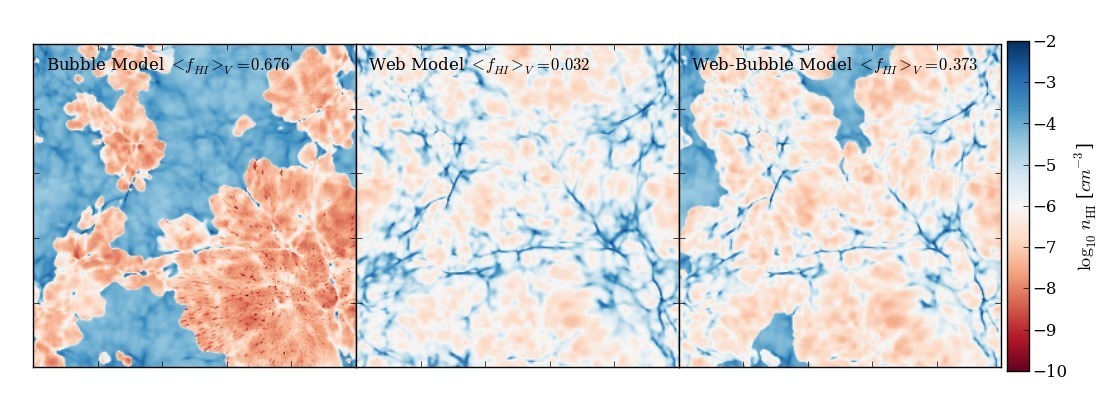In cosmology, one of the major challenges in next decades will be probing the epoch of reionization in the early universe. Scientists at MPA, the University of Oslo, and INAF have now used cosmological hydrodynamical, radiative transfer simulations to understand the impact of the complex distribution of neutral gas in the intergalactic medium on distant galaxies.Combining the simulations with observations of so-called Lyman alpha emitting galaxies they find that despite the uncertainty, the current simulation-calibrated measurements favour a late and rapid reionization history. The study also emphasizes that both the large-scale distribution of ionised gas regions and the small-scale structures of the intergalactic gas around galaxies must be understood to derive more robust constraints on the reionization epoch.

The neutral hydrogen number density at a redshift of z=7 in slices of the simulations for different reionization models with large-scale ionized regions (bubble model), small-scale structures (web model), and both combined (web-bubble model).
The epoch of reionization, when early galaxies or black holes drastically transformed the global state of the universe from neutral to an ionized plasma, is one of the major unsolved mysteries in modern extragalactic astronomy. Big questions remain unanswered: What was the history of reonization? Which sources were responsible for driving it?
One possibility to probe the physical state of the universe at very early times is by observing distant, high-redshift 'Lyman-alpha emitting galaxies'. These galaxies are emitting a strong Lyman alpha line, i.e. radiation from hydrogen gas in their interstellar medium. This strong emission line enables astronomers to observe these objects out to very far distances, at redshifts as high as 10. By now, hundreds of Lyman alpha galaxies have been found beyond redshift 6.
Observations show that the apparent demographics of Lyman alpha emitting galaxies changes over cosmic history. Beyond redshift 6, i.e. when the universe was less than 1 billion years old, the observed population of galaxies with Lyman alpha emission suddenly decreases. This is difficult to explain with galaxy formation alone. From medium to high distances (redshift 2 to 6), the fraction of star-forming galaxies that show a strong Lyman alpha emission increases, which is partly caused by less dust in these galaxies. Therefore, the sudden drop at very hight distances, beyond redshift 6, seems to indicate that something is blocking this kind of light. This drop is often interpreted as evidence of the gas in the universe being increasingly neutral at earlier cosmic times – this means the drop marks the time of reionization.
The idea to use Lyman alpha emitting galaxies as a probe of reionization is based on a simple idea. With more neutral gas along the line-of-sight to the galaxies, less Lyman alpha flux reaches the observer. The difference between the expected flux from a galaxy and the observed flux then tells us how much neutral gas exists along the line-of-sight.
For more information about this study, visit: http://www.mpa-garching.mpg.de/341980/hl201605
